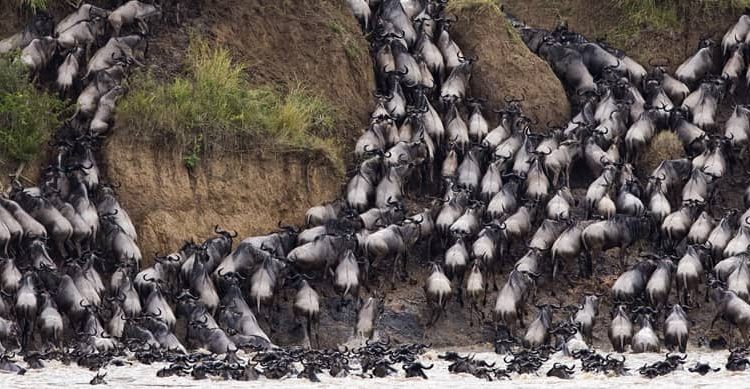
Serengeti National Park | Home of wildebeest Migration
Serengeti National Park | Home of wildebeest Migration
Serengeti national park is home of the great migration, no one talks or dreams of Serengeti national without thinking of the wildebeest migration. The wildebeest migration is one of the seven wonders of the world on wildlife history happening annually in Serengeti national park accompanied by the co-grazers like thousands of Zebras, Gazelles, Eland and impala.
Serengeti national park is much famous for the wildebeest migration that makes most people term the park as Serengeti national park is home of the migration. The wildebeest migration pattern can be easily predictable as they follow the months and weather or season of the year hence making it a year around movement while Serengeti national park remains the focal point of the migration.
The most determinant factor for the wildebeest migration is the rainfall pattern of the year, this makes each month the activity happens on one sector of Serengeti to another and the wildebeest follow all the migration patterns at ease. During this movement the wildebeest look for short grass across the Serengeti national park, moving from one corner of the park to another as they keep predicting what is a head of them, where to go next and at what time to go. They never fail in there itinerary as they now have great experience in their movements that happen year around but within Serengeti national park hence Serengeti national park is home of the migration!
The wildebeest Calendar follows the two seasons of rainfall in Serengeti those are: the first rains which are longer and heavy fall around April to May and the short rains which fall around November and they are small.
Wildebeest do not like staying in an area where there is tall grass where predators can easily ambush them but like being in an area where there is short grass where they can see long distance as a means of self-defence to them.
In November and early December, the herds of wildebeest arrive at the short-grass of the South and Eastern part of Serengeti just near the central seronera area, moving slowly as they head to Ndutu area located on the Northern part of the Ngorongoro conservation Area. The wildebeest at this period are scattered along the open endless plains of the Ndutu area, thousands of Zebras are also mixed up on this group as they move together.

The wildebeest will stay from here throughout January, February and March as it’s the calving season when thousands of newly born calves takes place. These area is good with fresh nutritious short grass that the newborn calves together with their mothers feed on, the process of calving takes only 1 to 2 weeks since thousands are born daily. This is great time to witness the labour ward of nature at Serengeti making it true that Serengeti national park is home of the migration since all the wildebeest are born in Serengeti not Maasai mara or any other park.
Around April when the rains start, the wildebeest start their journey to the central Serengeti Seronera area as the look for fresh grass and water around the Moru Kopjes in Seronera area. This is one of the best times though very muddy to visit Serengeti, the park is not crowded and the animals are easily spotted and near at the tracking turners at the park, millions and thousands of animals are around the Seronera area in addition to the permanent animals of Seronera area.
From June to July the wildebeest continue with their grazing style while moving to the North of Serengeti around the Grumeti River. The Grumeti area is part of the central Serengeti that offers high concentration of predators, though many guests start coming to the park during this time most of the lodges are prices are high we do not recommend staying around this area during this season unless the guest is luxury guest. The wildebeest continue with their movement further to the Northern Serengeti to the border as they prepare for their tactical and deadliest crossing of the Mara river to the Maasai Mara Reserve in Kenya.
The crossing starts with the crossing of the Grumeti River at the busiest schedule in the Central Serengeti national park through Seronera River, the wildebeest run the gauntlet of predators like lions, leopards, crocodiles, and many more. In August is always the true time when the wildebeest cross the Mara river survival for the fittest, the wildebeest crossing has great record of high death rate during going than crossing back. After they crossed to Kenya Maasai mara they graze from there for the period of two to three month before they cross back during the short rains of November in Serengeti.
It’s out of this circular movement that the park is much famous with the wildebeest migration than Maasai Mara, Serengeti national park is home of the migration.


